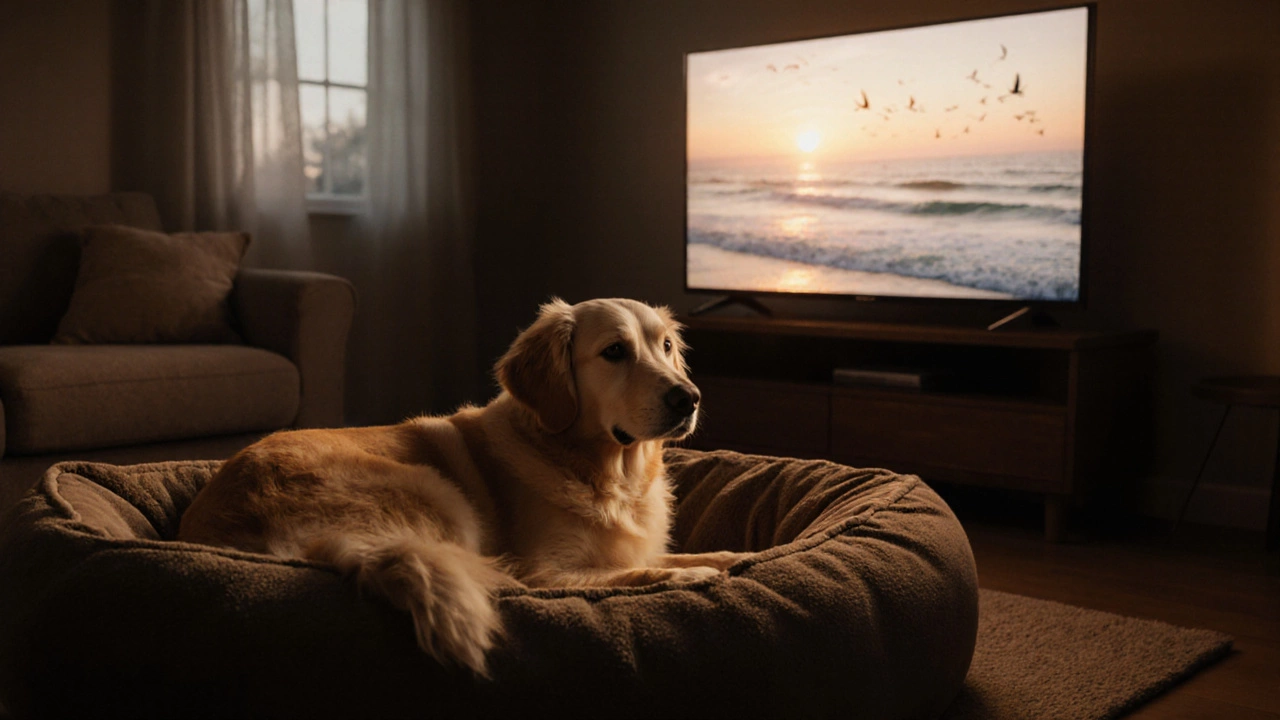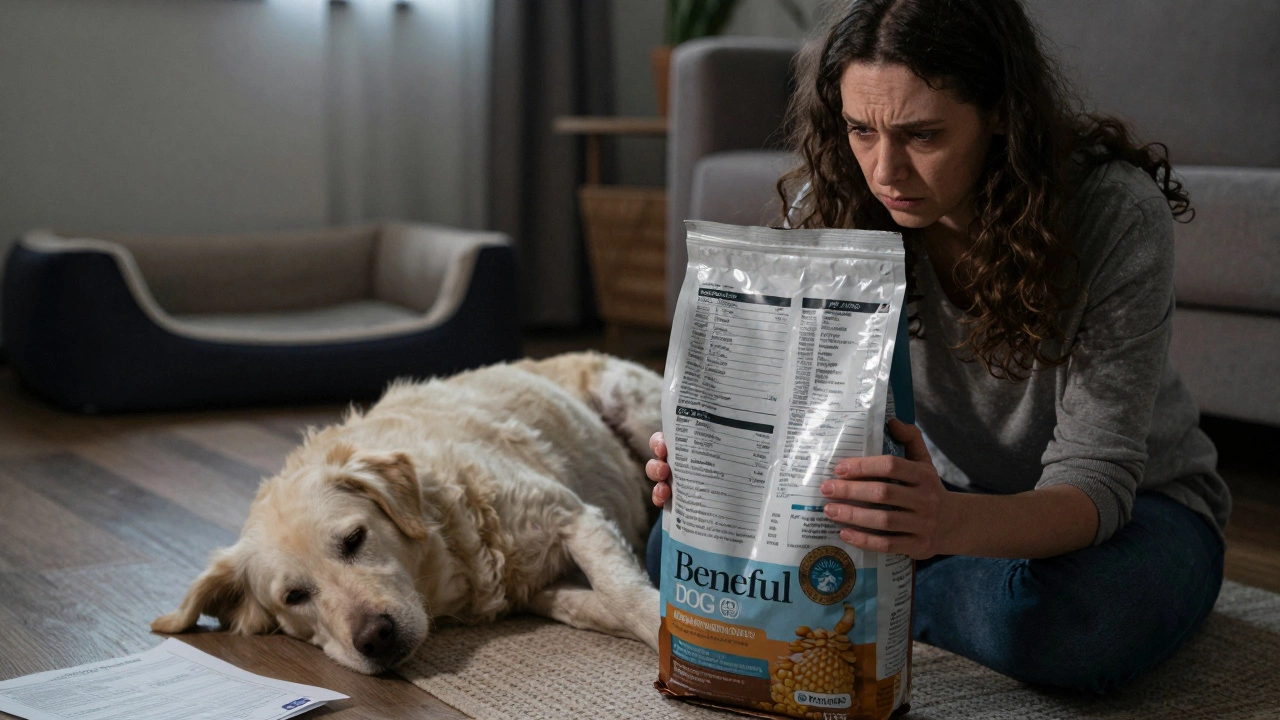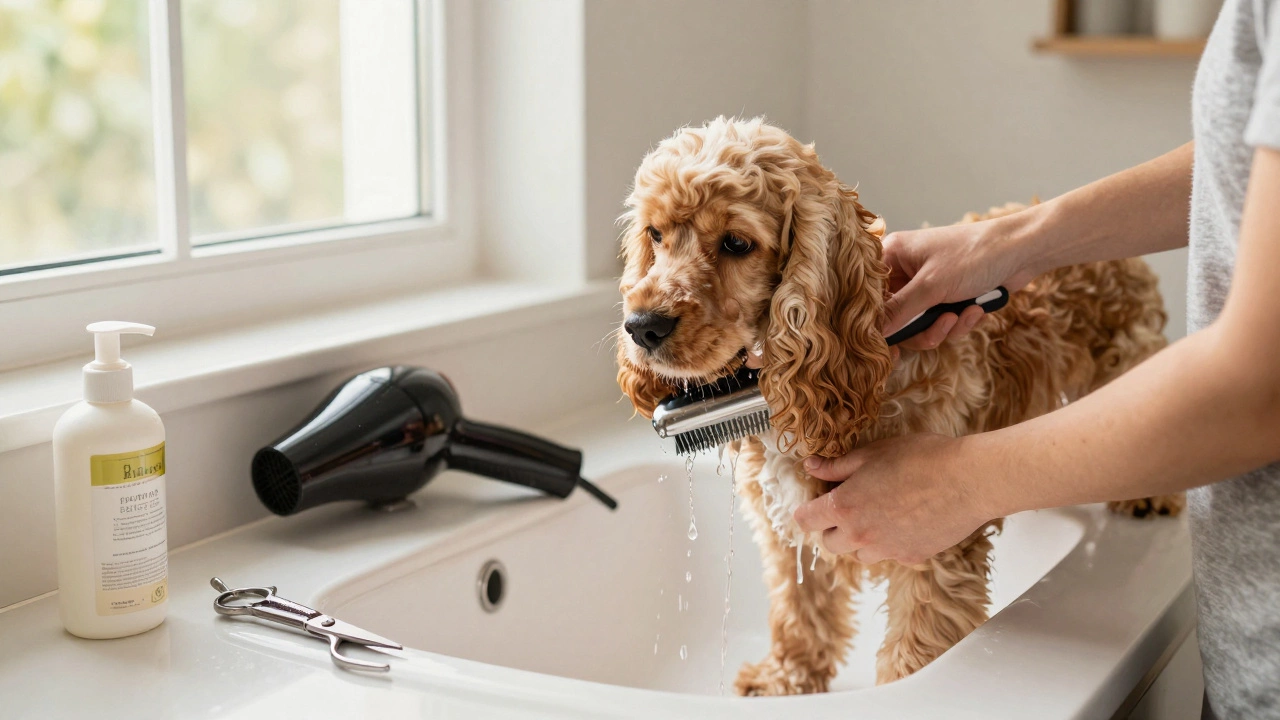Dog TV Volume Calculator
Optimal TV Volume for Calming Dogs
Select your TV's maximum volume level to calculate the ideal range for your dog. Research shows dogs calm best at 40-50% volume where you can comfortably talk without shouting.
Recommended Volume Range
Set volume between 40 and 50 percent.
Tip: If you can hear the TV clearly from across the room, it's probably at the right level for your dog.
Important Tips
For best results:
- Choose calm content like nature documentaries or soft music
- Keep volume low (never above 50% max volume)
- Monitor your dog's body language for signs of stress
- Combine TV with other enrichment activities
Ever wonder why some pups seem to settle down when the TV is on? You’re not dreaming-there’s actually research behind that soft hum of dialogue and music. This article breaks down how a constantly‑running television can affect a dog’s stress levels, when the trick works, and what to avoid so you don’t swap one problem for another.
What the TV Really Does for a Dog
Television is a visual and auditory device that streams moving images and sound, often used for human entertainment. For dogs, the continuous background noise and shifting pictures can serve as a form of ambient stimulation, similar to a low‑level white‑noise machine. The key is that it creates a steady soundscape, masking sudden noises that might otherwise startle a sensitive canine.
When Ambient TV Helps: Real‑World Scenarios
- Separation anxiety - Dogs left alone for long stretches may howl, bark, or destroy furniture. A gently humming TV can distract them and reduce the feeling of emptiness.
- Long days at the office - If your dog spends eight hours with you gone, the background chatter can mimic a “human presence,” easing boredom.
- New puppy adjustment - During the first few weeks, a puppy’s world is noisy and confusing. Soft TV sounds can create a predictable auditory pattern.
In each case, the TV works as a form of ambient sound that provides low‑level sensory input. It’s not a cure‑all, but it can be a useful tool in a broader enrichment plan.
Potential Downsides You Need to Know
While the idea sounds harmless, there are pitfalls:
- Overstimulation - Fast‑paced shows with loud explosions can actually raise stress, especially if the dog can’t distinguish between fiction and reality.
- Volume matters - Too loud, and the TV becomes a source of noise pollution, potentially damaging hearing.
- Dependency - If a dog learns it can only calm down when the TV runs, you may face a new problem when you need quiet.
The goal is to keep the TV at a low, steady volume and choose content that’s visually calm and aurally soothing.
Choosing the Right Content
Not all shows are created equal. Here’s a quick cheat‑sheet for picking dog‑friendly programming:
- Nature documentaries with gentle narration and soft background music.
- Cooking shows where the camera stays mostly on a static kitchen scene.
- Slow‑moving sitcom re‑runs with low‑key laugh tracks.
- Audiobooks or podcasts played through the TV’s speakers can work, too, as long as the volume stays modest.
Avoid action movies, horror flicks, or any program with frequent loud bangs, high‑pitch screeches, or rapid scene changes. Those can spike a dog’s heart rate and lead to the opposite of calm.
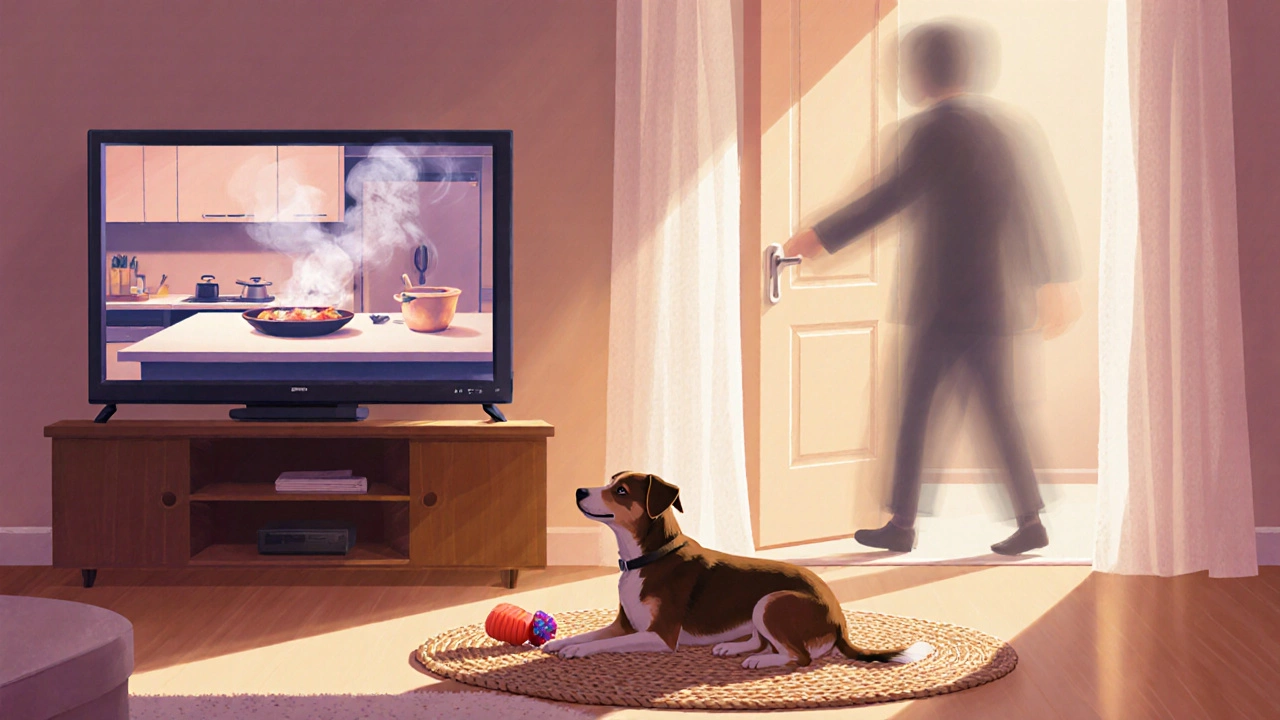
How to Set Up a Dog‑Friendly TV Routine
Follow these steps to make the TV a useful part of your dog’s daily routine:
- Pick a spot where your dog can comfortably watch - a dog bed or mat near the TV.
- Set the volume between 40-50% of maximum. Aim for a level where you can talk without shouting.
- Choose a playlist of 2-3 calm shows. Loop them so the TV never goes dark.
- Start the TV a few minutes before you leave the house. Let your dog settle in.
- Gradually reduce the TV’s “on” time over weeks as your dog becomes less dependent.
Keep an eye on your dog’s body language. If you notice tail‑tucking, lip licking, or excessive panting, switch to a quieter alternative.
Comparing Ambient TV to Other Sound Options
| Option | Effect on dog anxiety | Cost | Ease of Use |
|---|---|---|---|
| Television (calm shows) | Moderate reduction; works as visual + auditory stimulus | Low (already owned) | Very easy - just press play |
| Radio (soft music) | Good reduction; no visual distraction | Low‑moderate (radio or streaming service) | Easy - set a station |
| White Noise Machine | Strong reduction; consistent sound only | Moderate (one‑time purchase) | Easy - plug in and set volume |
| No background sound | May increase anxiety if the house is otherwise quiet | None | Not applicable |
Each method has its pros and cons. The TV’s advantage is the combination of soft visuals and sound, which can resemble a gentle human presence. If you already own a TV, it’s the cheapest entry point.
Integrating TV Time with Other Enrichment Tools
Don’t rely on the TV alone. Pair it with classic puppy toys like chew ropes or puzzle feeders to give your dog a physical outlet while the background noise works on the mind. A typical enrichment session could look like this:
- Turn on a calming nature documentary.
- Place a Kong stuffed with peanut butter on the floor.
- Let your dog work on the toy while the TV provides steady background sound.
- After 10‑15 minutes, switch to a short walk or a quick training drill.
This multi‑sensory approach tackles boredom, mental fatigue, and stress all at once.
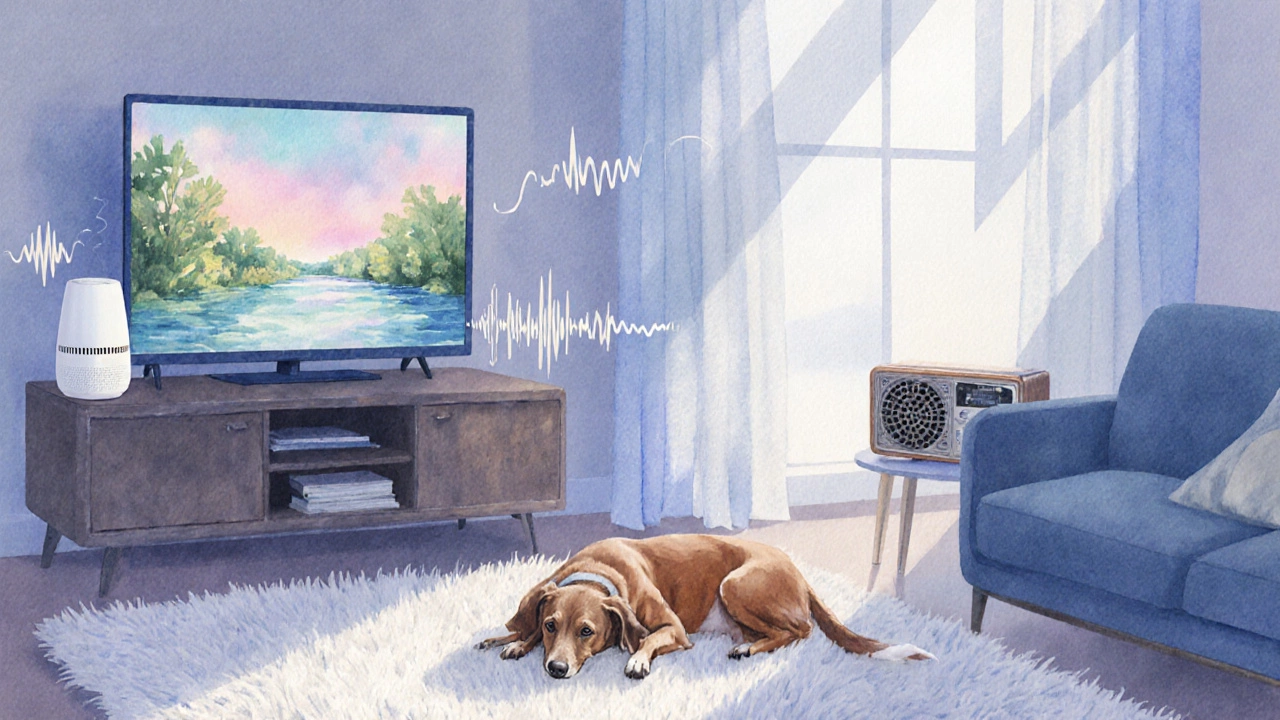
Common Myths About Dogs and TV
Myth #1: Dogs watch TV like humans. False. Dogs see motion and hear sound, but they don’t follow plotlines. They respond more to movement and tone.
Myth #2: Any TV volume will help. Wrong. Volume that’s too loud can cause hearing damage and increase anxiety.
Myth #3: Leaving the TV on all day is a substitute for human interaction. Incorrect. Interaction, exercise, and mental challenges remain essential.
Quick Summary
- Low‑volume, calm TV can mask sudden noises and lower dog anxiety in short bursts.
- Choose soothing content; avoid loud, fast‑paced shows.
- Combine TV with physical toys and regular exercise for best results.
- Monitor your dog’s reactions and adjust volume or content as needed.
- Use TV as a supplement, not a replacement, for human interaction.
Frequently Asked Questions
Can I leave my TV on all night for my dog?
It’s usually safe if the volume stays low and the program is calm, but dogs still need dark sleep cycles. A better approach is to turn the TV off after a couple of hours and let the dog rest in a quiet room.
Will the TV help a dog with severe separation anxiety?
It can reduce mild to moderate anxiety, but severe cases often need a professional behavior plan, training, and possibly medication. TV is a helpful supplement, not a stand‑alone cure.
What volume level is safest for my dog?
Aim for a volume that’s comfortable for a conversation - about 40‑50% of your TV’s max setting. If you can hear it clearly from across the room, it’s probably fine.
Should I use subtitles or captions?
Subtitles don’t affect the dog, but they can be useful for you if you’re multitasking. Just keep the screen’s brightness moderate to avoid overstimulating your pet.
Is a white‑noise machine better than TV?
White‑noise offers consistent sound without visual distraction, which some dogs prefer. If your dog reacts to motion, a white‑noise machine might be the safer bet.
By testing a few options and watching how your dog responds, you’ll find the right balance of background sound that keeps your furry friend calm without creating a new dependency. Happy watching!

